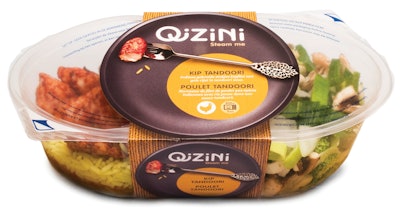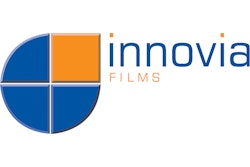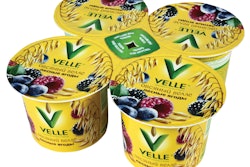Active packaging, intelligent packaging, smart packaging—the terms are often used somewhat interchangeably. But generally speaking, all three terms refer to a class of packaging that goes beyond packaging’s four most fundamental functions: contain, protect/preserve, transport, communicate.
Here in no particular order are a few examples of recently introduced and commercially available packages that take advantage of new active and intelligent packaging technologies. We begin with a microwave-shielding technology from Shieltronics that makes it possible to control the intensity of microwaves in a microwave oven so that foods requiring less microwave energy than others can all be prepared in one convenient cooking cycle lasting four to six minutes.
While some foodservice customers have been putting this technology to use for the past year or so, it has not been used commercially in retail channels. That could change soon thanks to developments now underway at Conveni, an innovative food manufacturer in Liessel, the Netherlands. Conveni is a brand new company whose Managing Director Wiebe Visser just acquired the ready meals and pizza business of Dutch food manufacturer Qizini. That firm’s Qizini brand ready meals (photo shown) will be moving through retail channels under the Conveni brand just as soon as existing packaging material inventory is depleted.
Available primarily in the Netherlands for the past several years, the Qizini/Conveni ready meals are already in an active package. It’s an idea originally developed and patented by Dutch food developer CH Food, where the concept went by the name of Variable Heating Steaming. Qizini, which licensed the technology from CH Food, refers to the pack as Steam Cuisine. It’s a two-compartment injection-molded polypropylene container that is semiautomatically filled with vegetables in one compartment and raw or partially cooked protein (fish, chicken, meat) in the other. Before it has a low-density polyethylene film lidding material heat-sealed to it on a Sealpac tray sealing machine, two key things happen. First, a proprietary laser system puts minute perforations in the lidstock in three areas. Two sets of perfs—call them Area A and Area B—are designed to be over the vegetable compartment. The other set of perfs—call it Area C—is over the protein compartment.
At this point the protein compartment is evacuated and backflushed with a gas mix that prolongs refrigerated shelf life to the desired eight or nine days. Then the lidstock is heat sealed to the perimeter flange as well as to the top of the injection-molded wall that separates the two compartments. The end result is an MAP compartment for protein and a separate compartment for vegetables.
Next comes another bit of proprietary innovation. Two small LDPE pressure-sensitive labels about 10 mm in diameter are applied over perforation Area B and perforation Area C. These labels are designed to open slightly and release some of the internal pressure that builds up when the consumer cooks the meal in the microwave oven. Without this venting feature, the package would burst during cooking. The label on the protein side also ensures that the modified atmosphere environment is maintained.
As for perforation Area C on the vegetable side, it remains uncovered. Its role is to allow the fresh vegetables to respire: oxygen in, carbon dioxide out. Without this controlled exchange of gases, the vegetables would spoil in a day or so.
Exiting the Sealpac machine, lidded trays have a paperboard sleeve manually applied. With that, the 450-g packages enter refrigerated distribution and eventually are bought by consumers for about 4 to 5 Euros. Cooking is a matter of removing the paperboard sleeve and placing the two-compartment container in the microwave oven for four to six minutes. Cooking is done by a combination of steam and pressure, and because the laser perforations in Area A and Area B are made as precisely as they are, the intensity of steam and pressure is greater in the protein compartment than in the vegetable compartment. That’s why raw products such as broccoli and salmon, whose cooking requirements are so dissimilar, can be conveniently cooked together.
Conveni Managing Director Visser says the taste and texture of the foods cooked in this Steam Cuisine approach are better than any other ready meals alternative out there. “But,” he adds, “there’s room for improvement. Even greater control of cooking times and temperatures can be achieved through the Shieltronics technology. We’ve had significant success with it in large-scale tests. At its most extreme, you can put water in the unshielded compartment and frozen ice cream in the other, and when you open the microwave the water will be boiled and the ice cream unfazed and ready to enjoy. Not that you’d ever want to push the technology to such extremes. But it shows you what it’s capable of.”
Shieltronics’ microwave-absorbing Shieltron material is incorporated in a container by way of in-mold labeling. Shieltronics and Conveni have relied on injection molder Cups4You to supply containers for much of their testing activity. One such container is shown at right.
And what exactly is the makeup of the Shieltron material? Shieltronics’ Dick Geheniau describes it as a multilayer lamination of PP/microwave-influencing foil/PP. The outside PP layer, he says, is printed prior to lamination. The material, notes Geheniau, can be formulated to allow as much or as little microwave power as is desired.
Visser calls the microwave-shielding concept “a great invention.” He continues.
“What led us to Shieltronics is that we are dedicated to producing an uncompromised ready meal. Emerging active and intelligent packaging technologies can help us do that. It will let us put dissimilar foods requiring very different cooking times in a single package that can be conveniently cooked in the microwave without requiring the consumer to cook them separately.”
Powerful serialization technology
We turn from the Netherlands to India for our next look at a smart packaging technology that is paying dividends, this time in the hardware category. The user: JK Files (India) Ltd., a subsidiary of Raymond Ltd. The technology provider: Kezzler.
JK Files is the world’s largest producer of hand files, which are sold chiefly through hardware store channels. The firm holds a 32% global market share of the hand-held files business, and it exports 50% of its products to more than 100 countries, including the U.S., Canada, and a variety of European nations. As counterfeit products, many from China, began to tarnish the firm’s reputation for top quality, management turned to the serialization system developed by Kezzler. Flexible film packages each get a unique QR code that is thermal-transfer printed. The buyer of the file can then scan the code or text the adjacent number to know immediately if the file is authentic or fake.
“It’s a form of smart packaging that empowers the purchaser to verify that this is an authentic product and not a fake,” says Avi Chaudhuri, Senior Director at Kezzler. “It also empowers the brand owner to communicate with consumers, to engage them in a novel way. It opens up an electronic portal between consumer and brand owner. Promotions, new products, loyalty programs, coupons—it can all be made available to the consumer. And the real-time business intelligence is just as important to the brand owner. JK Files knows when the product was sold and where.”
Also using the Kezzler technology is Pfizer in Hong Kong for its Lipitor, Norvasc, and Viagra brands. The cartons containing these products have a peel-off label. The consumer is instructed to peel it off to find a 15-digit unique verification code. Once again, consumers can use their phones to text the code to a verification center; they’ll receive a reply message telling them whether product is genuine or not. Or they can go online to input the code and see a summary of their product on the screen.
One experienced industry observer and consultant who finds the Kezzler technology especially significant is KPMG Advisory’s Geert de Vries, who specializes in helping brand owners prevent counterfeiting and parallel trade. He points to a Kezzler implementation in the energy drink category that involves billions of codes.
“The significance of this energy drink application is that generally IT systems have not been capable of handling enormous numbers of unique codes,” says de Vries. “Look at the new law in Europe that requires all pharmaceutical products have a unique code. That will come to about 17 billion codes per year, and when you extend that out three or four years, you’re looking at about 50 to 60 billion unique codes. Even the big SAP and Oracle systems aren’t capable of running those kinds of numbers. The Kezzler solution seems to be the only one that will. It’s because they don’t store the actual code in the data base. They store the algorithm instead. It lets them handle billions and billions of unique identifiers with a response time of less than one second.”
De Vries anticipates rapid growth of serialization, and not just in pharmaceutical applications.
“We think mass serialization is incredibly important going forward because it is capable of accomplishing three important goals,” he says. “First is data collection. You know exactly how long it takes for your product to go from production to the end consumer and you know exactly where the end consumer is. You also know which packaging is selling best by seeing how much contact consumers make with your data base. This is valuable in pharmaceuticals, of course, but also in consumer products and food and beverages, too. Second, there’s authentication. And third is marketing—you can ask consumers to scan the code because they can win a prize, for example, and once they scan it you can offer information on related product they might buy.”
As for the cost of the Kezzler technology, Chaudhuri estimates it at about a penny per product if volumes are in the range of 50 million units per year. As volumes climb even higher, the cost comes down even further, he adds.
Reducing food waste
Our last look at active & intelligent packaging takes us to the UK produce market, where the Asda chain of supermarkets is working with Ultimate Packaging and QV Foods to extend the shelf life of Extra Special Cornish Crystal Potatoes. Grown in England’s Cornwall region, these spuds are known for their creamy, soft, tender flesh and fluffy skin. They’re harvested about two weeks ahead of other English new potatoes because of the warmth Cornwall receives from the Gulf Stream.
QV Foods is packaging the potatoes in something that Ultimate Packaging calls Viridiflex. The material is positioned as being something that’s good for the environment, so the name is a combination of the Latin “viridis” for “green” and “flex” for flexible packaging. Precise material specs from Ultimate Packaging are hard to come by. But it’s an adhesive lamination consisting of an unnamed and proprietary layer that is joined to a layer of Natureflex. Made by Innovia Films, Natureflex is a bio-film made of wood pulp from managed plantations. It is certified to the European and American norms for compostable packaging. It’s also known for having high gloss and providing a degree of permeability to moisture.
What Viridiflex addresses is the fundamental fact that fresh produce, because it’s alive, continues to respire. That is, it gives off CO2 and takes in O2. The excellent oxygen barrier properties of Viridiflex are manipulated using Ultimate Packaging’s Adapt MAP laser technology. This involves laser perforation patterns that optimize gas transmission through the film. The end result is that oxygen and CO2 levels are managed in such a way as to reduce the risk of the potatoes going bad. ASDA Produce Category Technical Manager Jon Wynn likes what he sees since the Viridiflex film replaced cast polypropylene.
“I am delighted with its performance,” says Wynn. “ASDA customers have benefited from a significant increase in product life and end of life product quality, highlighted by a 92% year on year reduction in complaints in the first five weeks of the Extra Special Cornish Crystal Potato season.”
Ultimate Packaging summarizes the properties of Viridiflex film as follows:
• made from compostable, renewable resourced materials
• contains 84% biobased materials
• laminated using water based/compostable adhesive
• high gloss and good clarity of film
• good strength when formed
• overall thickness of 45 microns
• permeability to water vapor of 360 g/sq m/24 hr
• typical Oxygen Transition Rate of 12 cc/sq m/24 hr at 23C and 0% relative humidity
The Viridiflex material is sent to QV Foods in rolls that are fed into a vertical form/fill/seal machine that produces the finished packs of potatoes.
“Over 70 percent of our product is delivered into the fresh and chilled food sector,” says Chris Tonge, Sales and Marketing Director at Ultimate Packaging. “This has seen the company take major technical leaps to advance their offering of innovative films to the marketplace. This experience together with technical knowledge and first rate testing facilities has perfectly positioned Ultimate to establish a new leading edge of active packaging that can extend shelf life.”


























